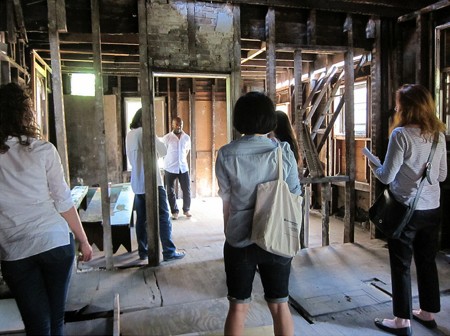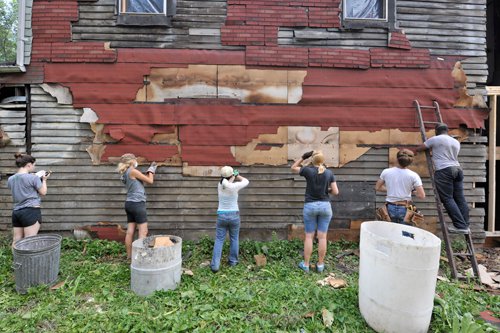
Theaster Gates leading a tour of a once-abandoned home that is now central to his creative rehab efforts in Hyde Park, St. Louis. Image courtesy of the Rebuild Foundation.
Artist Theaster Gates likes systems. And what he likes more than a system itself is knowing how to leverage it. Though formally trained in handling clay, Gates also uses the structure of neighborhoods, cultural institutions, and universities as his artistic medium.
Over the past few years, Gates has earned a reputation for his social-based practice, in which he intertwines art, urban planning, and community activism. In a recent conversation, he expressed frustration with the accepted scope of what it means to be an artist. He particularly dislikes the phrases “artist as change agent,” “artist as social worker,” or “artist as entrepreneur.” Gates explained that “the word ‘as’…shifts the possibility that an artist could be entrepreneurial, or have interest in the social, or have interest in architecture. It says you have to be ‘both this and this.’ It separates a person into these compartments. Versus: ‘I’m an artist and my skill set includes these things.’” With degrees in Ceramics, Urban Planning, and Religious Studies – and a brief stint in Pre-Pharmacy – Gates embodies the myriad identities that can be folded into being an artist.
Though Theaster Gates is nearly a household name in Chicago and is widely recognized throughout the art world – he was included in the 2010 Whitney Biennial – he recently has garnered attention in St. Louis for his cultural revitalization initiatives. Last year, Gates founded the Rebuild Foundation, combining the various facets of his practice within a single non-profit organization. The Rebuild Foundation brings together artists, architects, developers, educators, and community activists to help revitalize under-resourced neighborhoods. It currently manages projects in Detroit, Omaha, Chicago, and St. Louis. In just one year alone, the Rebuild Foundation, with the energetic on-site commitment of Dayna Kriz, has become a major force in St. Louis’s Hyde Park neighborhood. Located in north St. Louis, Hyde Park is a historic neighborhood that has fallen upon hard times as a result of post-war deindustrialization and the ensuing population decline.

Juan William Chavez leading an experimental drawing workshop in conjunction with "Urban Expression: Theaster Gates." Courtesy the Pulitzer Foundation for the Arts.
At the center of Hyde Park is the Most Holy Trinity Catholic Church and School. In Spring 2010, Most Holy Trinity partnered with the Pulitzer Foundation for the Arts on a fifteen-week program called Urban Expression: Theaster Gates. The course was held in conjunction with Urban Alchemy: Gordon Matta Clark, an exhibition similarly inspired by issues of urban abandonment. Throughout the program, Gates worked with at-risk youths in developing reading, writing, and artistic skills that eventually culminated in a master plan for their neighborhood. The program concluded with an exhibition curated by Juan William Chávez at Bruno David Gallery, across the street from the Pulitzer Foundation. The partnership between the Pulitzer Foundation, Most Holy Trinity, Gates, and Chávez helped to counter the popular notion that institutional and grassroots initiatives are structurally devised to work in opposition to one another.

Building donated to the Rebuild Foundation in the foreground; Most Holy Trinity Catholic Church in the background. Photo by Stan Strembicki.
As the program came to an end, Gates wasn’t prepared to terminate the relationship he had established with the Most Holy Trinity students and the Hyde Park community. Instead, he made a more enduring commitment to the neighborhood, asking Dayna Kriz to help oversee a Saturday School program for the students. Also called Urban Expressions, the program now falls under the auspices of the Rebuild Foundation and continues to engage students in cultural and community stewardship. Though Urban Expressions has little in the way of financial resources, it has managed to survive and grow with the support of the Hyde Park community. Gates explained, “If we didn’t have capacity, we had enthusiasm. Where we didn’t have fiscal support, we had ingenuity. When we didn’t have anything, we had the relationships that we developed.”
Just months after kicking off the program, a building was donated to the Rebuild Foundation and the project snowballed yet again, expanding beyond its original scope. Perhaps one of the greatest successes of Urban Expressions is Kriz’s ability to empower others to take a stake in the project. She explains, “when I did not feel confident enough to lead this class and discussion, I reached out to someone who’s more of a professional. It was asking what I’m capable of and what I’m not capable of, asking people to fit where they want to fit.” Now, alongside a team of artists, architects, and community activists, the Rebuild Foundation and the Hyde Park community are working together to imagine the building’s future, exploring how it could be the impetus for community-driven revitalization.

Students removing the siding of the house during "Somethingness: Ways of Seeing and Building," a course led by Theaster Gates. Photo by Stan Strembicki.
After witnessing Gates’s commitment to Hyde Park, Washington University invited him to lead a summer course that would give students hands-on experience in considering both the theoretical and practical sides of cultural regeneration. Sponsored by the university’s Sam Fox School of Design & Visual Arts and the Pulitzer Foundation, Gates’s course, “Somethingness: Ways of Seeing and Building, concluded just this week. Over three intensive weeks, the course brought together students of social work, architecture, art, and design to work alongside local residents in exploring the possibilities for the donated Hyde Park building. In addition to the direct benefit of having institutional support and a committed team to work on the project, Gates explained that one of the greatest lessons of the course was learned through bringing together multiple disciplines. He said, “these disciplinary silos can sometimes, depending on your training, offer you a very narrow path by which you can live your life in service to the thing that you believe in. So what I’ve been trying to do instead is…to ask what it is that you believe in and what it is you’re interested in and how that can have consequence in Hyde Park.”
In addition to its activities in Hyde Park, the Rebuild Foundation has recently partnered with Beyond Housing to establish another arts-based community center in the heart of Pagedale, St. Louis. The project concentrates on the Salerno House and is managed by artist/social worker Regina Martinez. The combination of art and social work within St. Louis—as evinced not only by Gates’s summer course, but also by the number of culturally engaged students graduating from Washington University’s Brown School of Social Work—is becoming increasingly common (a development that I will explore in greater depth with my next post).
All-too-often, community engagement produces an imbalanced relationship and an artist or an institution sees itself as aiding a deprived community. However, Gates freshly appraises the idea of community engagement, elevating it beyond victimization and making it part of a two-way relationship. Rather than avoid the institutions that have historically contributed to class divisions, de-industrialization, or impoverishment, Gates works alongside them, exploring how institutional structures can be leveraged to more directly benefit the people and the neighborhoods that he cares about. As he explains, “I think about communities a lot, but I’m realizing that I don’t think about communities because I want to save them. I think about communities because I really love systems, and I love people, and I love thinking about how systems could be made better to support the people who live within systems.”





Pingback: Community Arts Training Institute: A Conversation with Roseann Weiss | Art21 Blog
Pingback: From the Magazine: Theaster Gates’ Art & Revival on Chicago’s Dorchester Avenue - PreservationNation